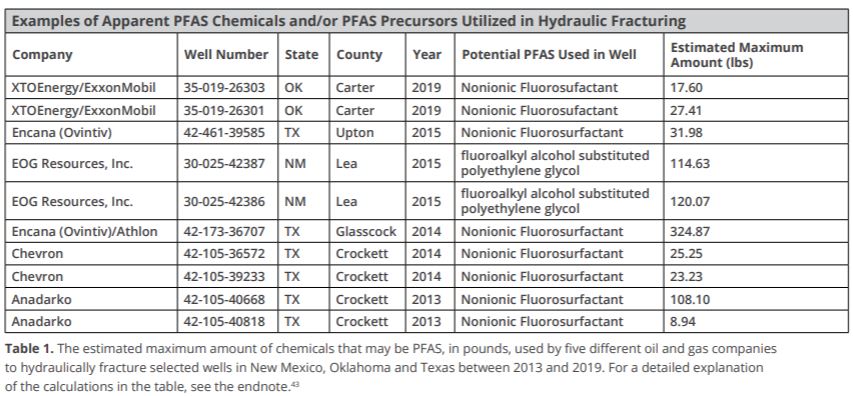

![]() Note household products listed in table above contaminated with these deadly chemicals include dental floss, shampoo, make-up, lotion, bug spray, sunscreen. We are indeed a stupid species. Too bad there are billions of us. We do not deserve life on this magnificent planet.
Note household products listed in table above contaminated with these deadly chemicals include dental floss, shampoo, make-up, lotion, bug spray, sunscreen. We are indeed a stupid species. Too bad there are billions of us. We do not deserve life on this magnificent planet.
One of the changes to my drinking water after Encana/Ovintiv illegally frac’d my community’s drinking water aquifers was that my water became super slippery to the touch. I could barely hold on to dishes to wash them, or my tooth brush, etc. I’d constantly rub fingers and thumb together under the tap, perplexed at the slick slippery change to my water. I dropped and broke many dishes (I wash my dishes by hand) and cut myself often.
Encana has used PFAS chemicals in frac’s in the USA, of course us up here in dim lit Caveman Canada we get no such vital information about what deadly chemicals companies are speeding and crashing through our communities, near schools, hospitals and parks where kids play, and inject into our drinking water supplies. Evil.![]()

2005: National Post Business asks “What does Gwyn Morgan know that the rest of us don’t?”
![]() Morgan was CEO of Encana when the company illegally frac’d Rosebud’s drinking water aquifers and turned my water well into a bomb in my barn, with water too dangerous (contaminated with methane and ethane and man made chemicals used in drilling/frac’ing) to even use to flush toilets. He knew what his company was doing. Those of us he harmed, did not. Beyond Evil. Unforgivable. Rot in hell fucker. May you breath deeply as you walk along the ocean sprayed shores of your multi-million dollar home in Oak Bay, BC. I often wonder what your loved ones think of you and your incessant greedy toxic secrets.
Morgan was CEO of Encana when the company illegally frac’d Rosebud’s drinking water aquifers and turned my water well into a bomb in my barn, with water too dangerous (contaminated with methane and ethane and man made chemicals used in drilling/frac’ing) to even use to flush toilets. He knew what his company was doing. Those of us he harmed, did not. Beyond Evil. Unforgivable. Rot in hell fucker. May you breath deeply as you walk along the ocean sprayed shores of your multi-million dollar home in Oak Bay, BC. I often wonder what your loved ones think of you and your incessant greedy toxic secrets.![]()

Above graph lists PFAS chemicals and or precursors used in frac’ing by Encana/Ovintiv in New Mexico, Oklahoma and Texas between 2023 and 2019.

Ocean spray emits more PFAS than industrial polluters, study finds, Research into release of ‘forever chemicals’ raises concerns about contamination and human exposure along world’s coastlines by Tom Perkins, 19 Apr 2024, The Guardian
Ocean waves crashing on the world’s shores emit more PFAS into the air than the world’s industrial polluters, new research has found, raising concerns about environmental contamination and human exposure along coastlines.
The study measured levels of PFAS released from the bubbles that burst when waves crash, spraying aerosols into the air.
It found sea spray levels were hundreds of thousands times higher than levels in the water.
The contaminated spray likely affects groundwater, surface water, vegetation, and agricultural products near coastlines that are far from industrial sources of PFAS, said Ian Cousins, a Stockholm University researcher and the study’s lead author.
“There is evidence that the ocean can be an important source [of PFAS air emissions],” Cousins said. “It is definitely impacting the coastline.”
EPA has limited six ‘forever chemicals’ in drinking water – but there are 15,000
PFAS are a class of 15,000 chemicals used across dozens of industries to make products resistant to water, stains and heat. Though the compounds are highly effective, they are also linked to cancer, kidney disease, birth defects, decreased immunity, liver problems and a range of other serious diseases.
They are dubbed “forever chemicals” because they do not naturally break down and are highly mobile once in the environment, so they continuously move through the ground, water and air. PFAS have been detected in all corners of the globe, from penguin eggs in Antarctica to polar bears in the Arctic.
The Stockholm researchers several years ago found that PFAS from ocean waves crashing are released into the air around shorelines, then can travel thousands of kilometers through the atmosphere before the chemicals return to land.
The new research looked at levels in the sea spray as waves crash by testing ocean samples between Southampton in the UK and Chile. The chemicals’ levels were higher in the northern hemisphere in general because it is more industrialized and there is not much mixing of water across the equator, Cousins said.
It is unclear what the findings mean for human exposure. Inhalation of PFAS is an issue, but how much of the chemicals are breathed in, and air concentrations further from the waves, is still unknown.
Previous non-peer-reviewed research has found a correlation between higher PFAS levels in vegetation samples and proximity to the ocean, Cousin said, and his team is undertaking a similar study.
He said that the results showed how the chemicals are powerful surfactants that concentrate on the surface of water, which helps explain why they move from the ocean to the air and atmosphere.
“We thought PFAS were going to go into the ocean and would disappear, but they cycle around and come back to land, and this could continue for a long time into the future,” he said.
Constraining global transport of perfluoroalkyl acids on sea spray aerosol using field measurements by Bo Sha, Jana H. Johansson, Matthew E. Salter, Sara M. Blichner and Ian T. Cousins, April 5, 2024, Science Advances Vol 10, Issue 14
- Abstract
- INTRODUCTION
- RESULTS
- DISCUSSION
- MATERIALS AND METHODS
- Acknowledgments
- Supplementary Materials
- REFERENCES AND NOTES
- eLetters (0)
Abstract
Perfluoroalkyl acids (PFAAs) are highly persistent anthropogenic pollutants that have been detected in the global oceans. Our previous laboratory studies demonstrated that PFAAs in seawater are remobilized to the air in sea spray aerosols (SSAs). Here, we conducted field experiments along a north-south transect of the Atlantic Ocean to study the enrichment of PFAAs in SSA. We show that in some cases PFAAs were enriched >100,000 times in the SSA relative to seawater concentrations. On the basis of the results of the field experiments, we estimate that the secondary emission of certain PFAAs from the global oceans via SSA emission is comparable to or greater than estimates for the other known global sources of PFAAs to the atmosphere from manufacturing emissions and precursor degradation.
![]()
Refer also to:

Encana/Ovintiv illegally dumped waste on foodlands at Rosebud, Alberta


2017: Australia Esso Longford plant: Toxic PFAS chemicals found in dam and groundwater
